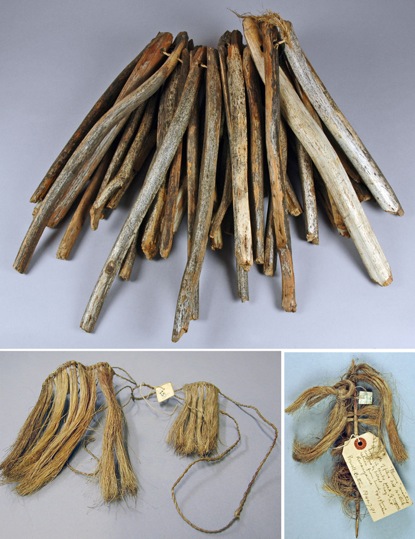Girl's stick skirt, false eyebrows, beard and hair-piece
Kwanyama people, Angola
 Collected by Antoinette and Diana Powell-Cotton 1936–1937, and donated by Antoinette Powell-Cotton in 1940; 1940.7.88 and 1940.7.91–.93Kwanyama describes the name and dialect spoken by a small Ovambo population who inhabit areas of northern Namibia and the Cunene province of Southern Angola. A Kwanyama bride wore this fringe of light, brittle aloe stalks tied around her chest, along with a larger skirt of similar sticks around her waist.
Collected by Antoinette and Diana Powell-Cotton 1936–1937, and donated by Antoinette Powell-Cotton in 1940; 1940.7.88 and 1940.7.91–.93Kwanyama describes the name and dialect spoken by a small Ovambo population who inhabit areas of northern Namibia and the Cunene province of Southern Angola. A Kwanyama bride wore this fringe of light, brittle aloe stalks tied around her chest, along with a larger skirt of similar sticks around her waist.
In Ovambo communities the husband and wife traditionally belonged to different matrilineages to ensure joint ownership and inheritance of property. However, women were not permitted to own land independently, and at the time this item was collected in the 1930s, when there were often large age gaps between young brides and older husbands, this resulted in a high rate of remarriage among widowed women.
According to Ovambo custom, the line between legitimate and illegitimate pregnancies was drawn by an initiation ceremony known as efundula. Pre-initiation pregnancies were believed to threaten the life of the king and the validity of the girl's lineage, therefore reducing her marriage prospects. Once initiated, a girl could engage in sexual intercourse; if she became pregnant, she quickly married. During the colonial period this caused problems when missionaries defined illegitimacy in terms of marriage rather than initiation, sometimes resulting in a pregnant girl's expulsion from the new religion. The daughter's parents had to provide cattle for both initiation and wedding feasts so during periods of subsistence crises, the age of initiation could extend to her late twenties or even early thirties.
After the efundula and subsequent marriage, a bride traditionally spent around a month living freely in the bush 'as a man'. She would wear this aloe stick chest fringe and skirt alongside other ornaments including a fake plant fibre beard (small ornament in the centre), huge fake eyebrows (large ornament to the left) and a hair-ornament (right), worn as a plume in the centre peak of her hairstyle. She also wore cane rings around the waist, wrists, and neck. This elaborate costume marked the culmination of the bride's time spent wandering about the countryside and was worn on the night of her return to the village and start of a new life in her husband's home.
